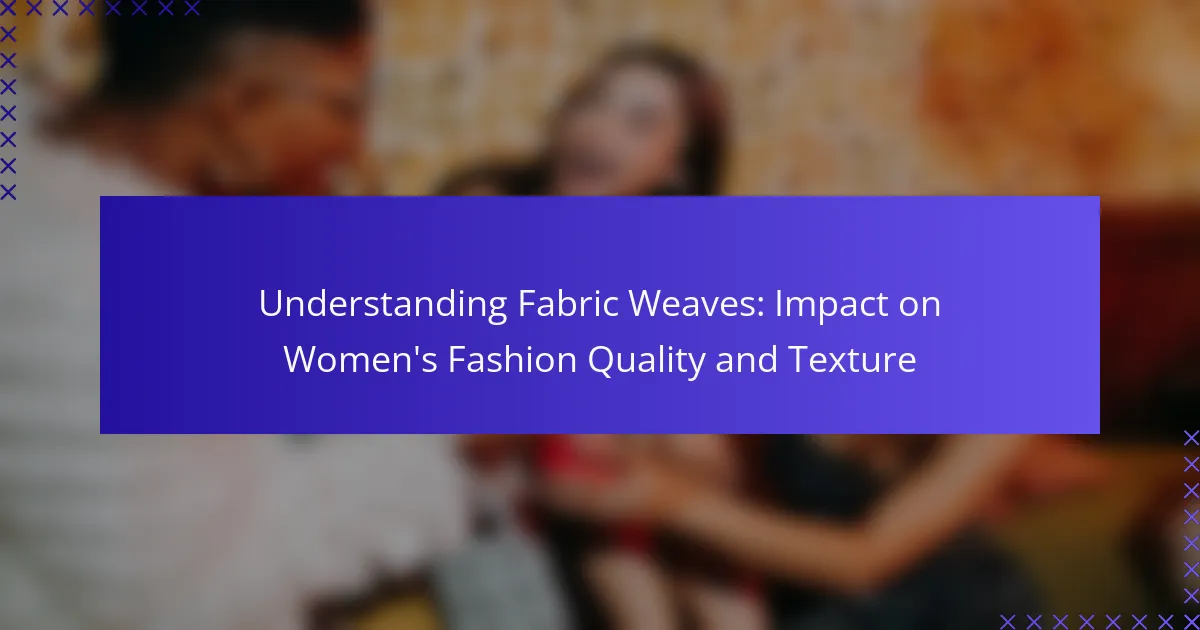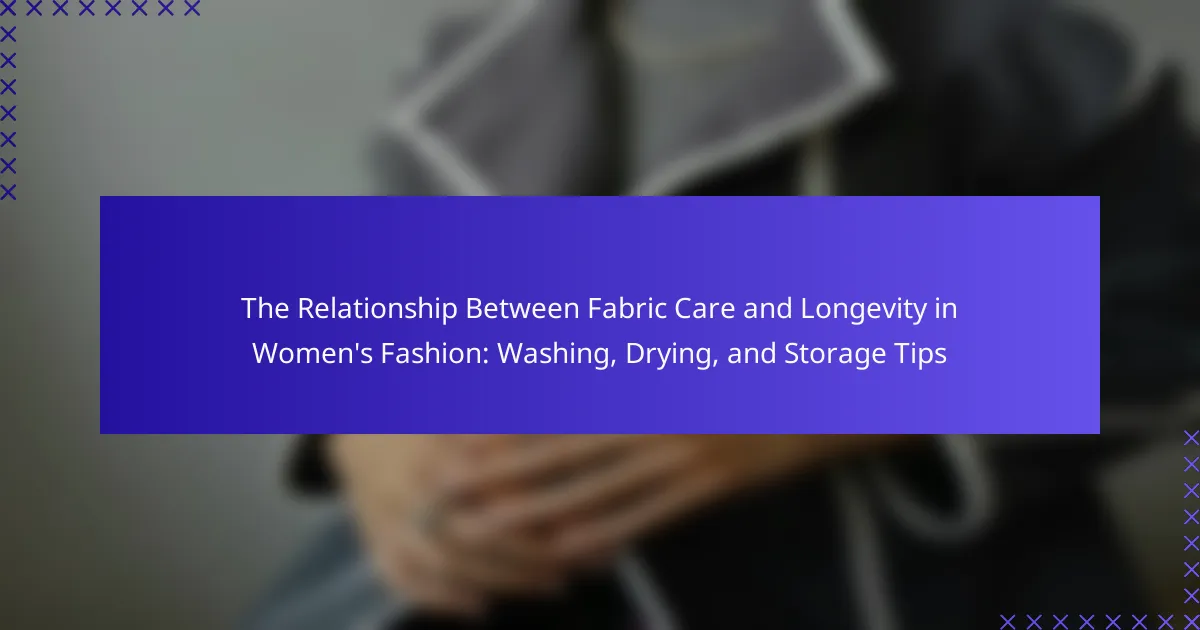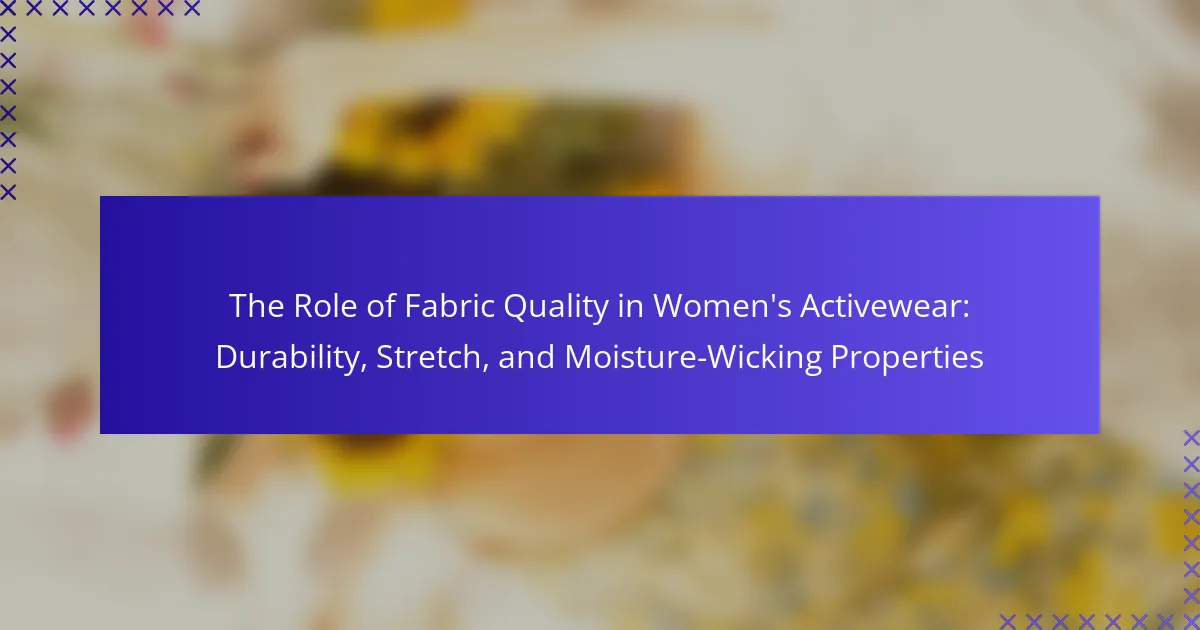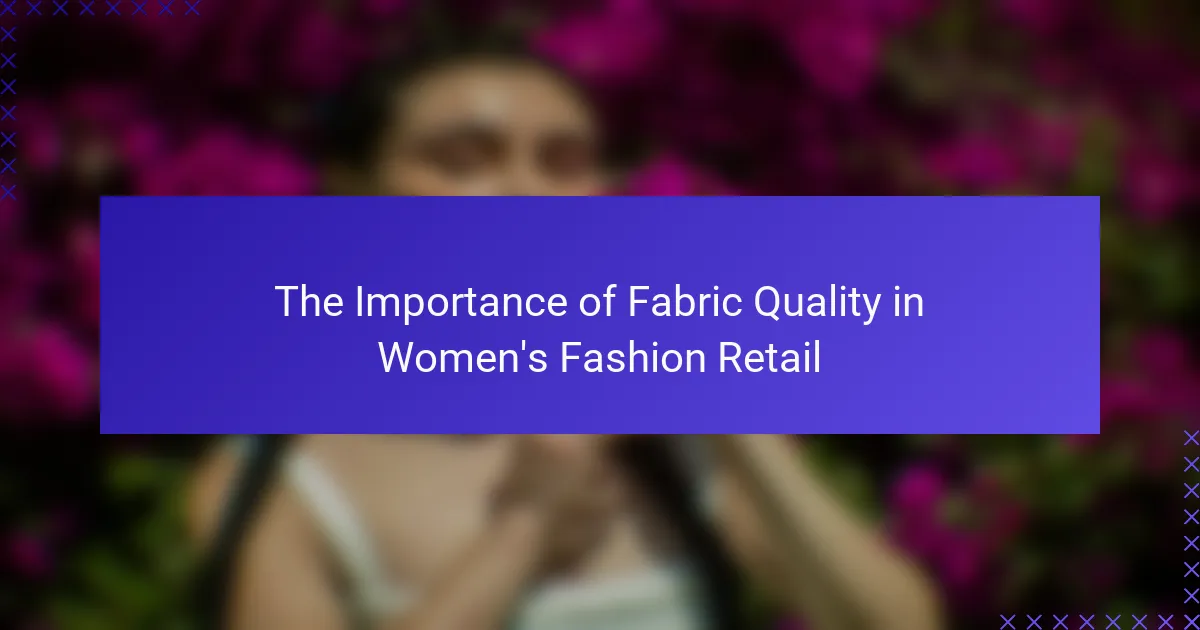Fabric weaves are the techniques used to interlace threads, significantly impacting the quality, texture, and appearance of textile materials in women’s fashion. Different types of weaves, such as plain, twill, and satin, create unique characteristics that influence a garment’s durability, elegance, and functionality. Current trends highlight the importance of sustainable materials, textured weaves, and innovative blends, reflecting a shift towards both aesthetic appeal and practical design. Understanding these weaves is essential for selecting the right fabric to enhance style and comfort in women’s clothing.
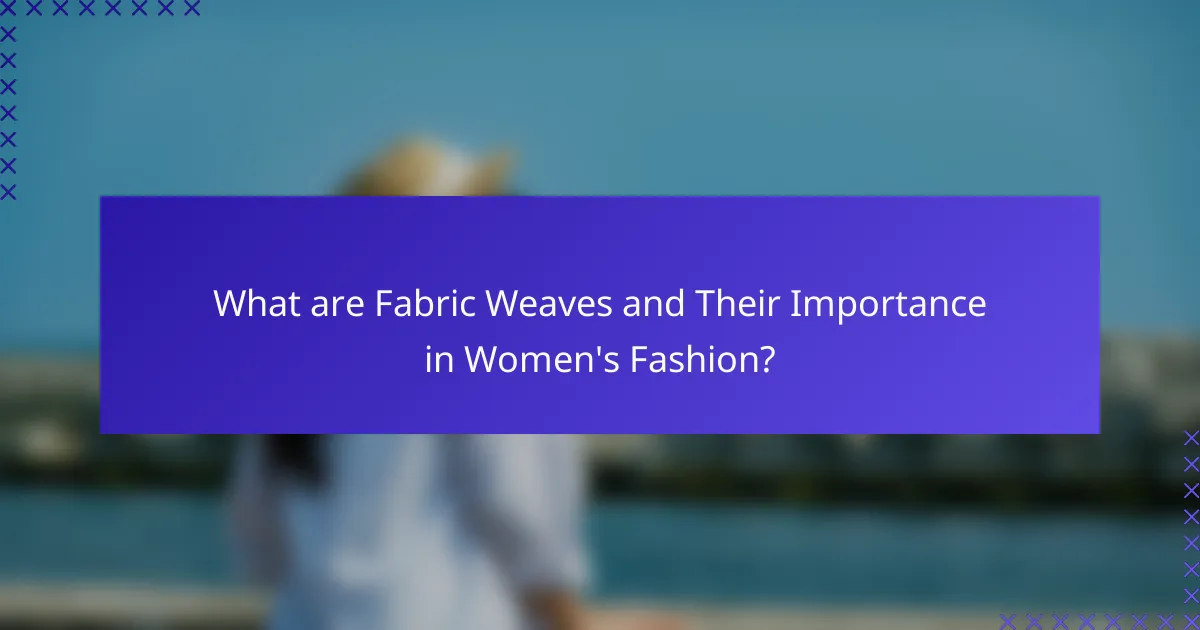
What are Fabric Weaves and Their Importance in Women’s Fashion?
Fabric weaves are the methods used to interlace threads to create textile materials. They determine the texture, durability, and appearance of fabrics. Different weaves, such as plain, twill, and satin, produce distinct characteristics. For instance, twill weaves create a diagonal pattern, enhancing strength and drape. Satin weaves offer a smooth surface with a glossy finish, ideal for formal wear. Fabric weaves significantly influence the quality of women’s fashion items. High-quality weaves enhance the garment’s longevity and comfort. The right weave can elevate a design, making it suitable for various occasions. Understanding fabric weaves is essential for selecting the appropriate material for specific fashion needs.
How do different fabric weaves affect the quality of women’s clothing?
Different fabric weaves significantly affect the quality of women’s clothing. Weaves such as plain, twill, and satin each offer unique characteristics. Plain weaves create a durable and breathable fabric, suitable for everyday wear. Twill weaves provide a diagonal pattern that enhances drape and strength. Satin weaves produce a smooth, glossy finish, often used for formal attire.
The choice of weave influences texture, weight, and appearance. For instance, a lightweight chiffon with a plain weave is ideal for summer dresses. In contrast, a heavier twill weave is preferable for structured garments like blazers.
Quality is also impacted by the yarn used in the weave. High-quality fibers like silk or high-thread-count cotton elevate the overall garment quality. Additionally, the weave can affect how well the fabric holds color and resists wrinkles.
Research indicates that fabric weave can alter the garment’s lifespan and comfort level. For example, a study by the Textile Research Journal found that twill weaves showed greater resistance to wear compared to plain weaves. Thus, understanding fabric weaves is essential for selecting high-quality women’s clothing.
What are the key characteristics of various fabric weaves?
Fabric weaves are the methods by which threads are interlaced to create textiles. Key characteristics include the weave type, texture, durability, and drape. Common weave types are plain, twill, and satin. Plain weave is simple and strong, making it versatile. Twill weave has a diagonal pattern, providing durability and a unique texture. Satin weave creates a smooth surface with a glossy finish, enhancing drape. Each weave affects the fabric’s appearance and performance. For example, twill is often used in denim, while satin is favored for evening wear. These characteristics influence the quality and texture of women’s fashion garments.
How do fabric weaves influence the durability of women’s fashion items?
Fabric weaves significantly influence the durability of women’s fashion items. Different weaves, such as twill and satin, affect the strength and resilience of the fabric. Twill weaves, for example, create a diagonal pattern that enhances durability. This structure allows for better tensile strength, making garments more resistant to wear and tear.
Conversely, satin weaves produce a smooth surface but can be more prone to snagging and damage. The tightness and density of the weave also play crucial roles. Tighter weaves generally result in stronger fabrics that withstand stress better.
Additionally, the type of fibers used in conjunction with the weave impacts durability. Natural fibers like cotton or wool can vary in strength based on their weave. In summary, the choice of fabric weave directly affects the longevity and durability of women’s fashion items through its structural characteristics and fiber interactions.
What role does texture play in women’s fashion?
Texture plays a crucial role in women’s fashion by influencing the overall aesthetic and tactile experience of garments. It affects how clothing feels against the skin, impacting comfort and wearability. Different textures can convey various moods and styles, from soft and romantic to structured and edgy. For example, fabrics like silk offer a smooth, luxurious feel, while denim provides a rugged, durable texture. Additionally, texture can enhance visual interest through contrast and layering, making outfits more dynamic. Fashion designers often use texture strategically to create depth and dimension in their collections. Studies show that texture can also influence consumer perception, with tactile qualities affecting purchasing decisions.
How does fabric texture impact the overall aesthetic of clothing?
Fabric texture significantly influences the overall aesthetic of clothing. It affects how garments appear visually and how they feel to the touch. Different textures can evoke distinct emotions and styles. For instance, smooth fabrics like silk convey elegance and luxury. In contrast, rougher textures like denim suggest a casual or rugged look. The interplay of light on textured fabrics can enhance visual interest and depth. Textured fabrics can also alter the silhouette of clothing, affecting drape and fit. According to a study by the Fashion Institute of Technology, texture is a key factor in consumer perception of clothing quality. This highlights the importance of fabric texture in fashion design and consumer choice.
What are the sensory experiences associated with different fabric textures?
Different fabric textures evoke distinct sensory experiences. For instance, silk feels smooth and cool against the skin. This texture often elicits a sense of luxury and elegance. Conversely, wool has a coarse and warm texture, providing a comforting sensation. Cotton, known for its softness, offers a breathable experience, making it ideal for everyday wear. Linen presents a crisp and slightly rough texture, contributing to a fresh, airy feel. Each fabric’s unique texture influences tactile perception and emotional response. Research indicates that texture significantly affects consumer preferences in fashion, impacting choices and satisfaction.
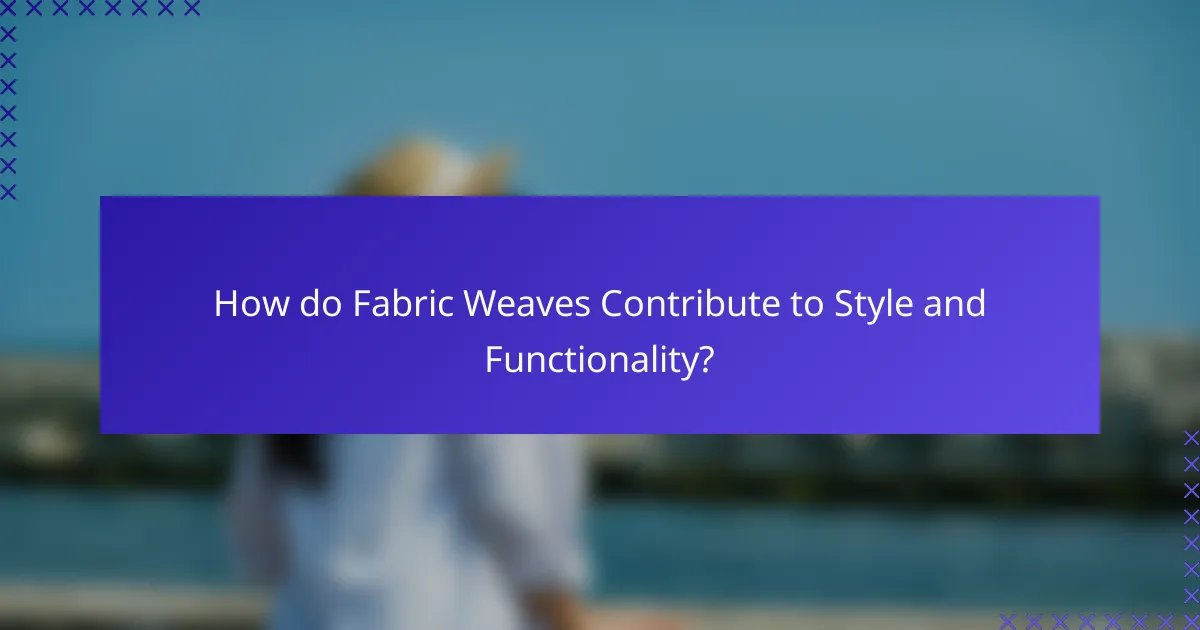
How do Fabric Weaves Contribute to Style and Functionality?
Fabric weaves significantly influence both style and functionality in textiles. Different weaves create distinct textures and appearances. For example, twill weaves result in a diagonal pattern, offering durability and a sophisticated look. Satin weaves produce a smooth and glossy surface, enhancing elegance in garments.
Moreover, the choice of weave affects the fabric’s breathability and drape. Lightweight weaves like chiffon provide flowy silhouettes, ideal for summer wear. In contrast, heavier weaves like denim offer structure and warmth.
Functionally, certain weaves improve fabric performance. For instance, ripstop weaves incorporate reinforcement to resist tearing, making them suitable for outdoor apparel. This versatility allows designers to select weaves that align with desired aesthetics and practical uses.
Overall, fabric weaves are foundational in shaping the visual appeal and usability of women’s fashion.
What types of fabric weaves are commonly used in women’s fashion?
Common fabric weaves used in women’s fashion include plain weave, twill weave, and satin weave. Plain weave is the most basic type, characterized by a simple over-and-under pattern. This weave is durable and often used in fabrics like cotton and linen. Twill weave features a diagonal ribbing, providing a softer texture and more drape. It is commonly found in denim and gabardine. Satin weave creates a smooth, glossy surface, making it ideal for formal wear and evening gowns. Each weave type contributes uniquely to the quality and texture of women’s clothing.
What are the benefits of using plain weave in women’s clothing?
Plain weave offers several benefits in women’s clothing. It is known for its durability, making garments long-lasting. The simple structure of plain weave provides a flat surface, allowing for smooth printing and dyeing. This weave is versatile, suitable for various fabrics like cotton, linen, and silk. Additionally, plain weave garments often have a crisp finish, enhancing their aesthetic appeal. The breathability of plain weave fabrics contributes to comfort, especially in warmer climates. Moreover, this type of weave tends to be cost-effective, making it accessible for a wide range of consumers. Overall, plain weave is a practical choice for quality women’s clothing.
How does twill weave enhance the style of women’s garments?
Twill weave enhances the style of women’s garments by providing a distinctive diagonal pattern. This pattern adds visual interest and texture to the fabric. Twill also drapes well, creating flattering silhouettes. The structure of twill makes garments more durable and resistant to wrinkles. This durability allows for long-lasting wear, maintaining a polished look. Additionally, twill fabrics can be made from various materials, such as cotton or silk, offering versatility in style. The unique attributes of twill contribute to its popularity in women’s fashion. Overall, twill weave elevates the aesthetic and functional qualities of women’s garments.
Why is understanding fabric weaves essential for fashion designers?
Understanding fabric weaves is essential for fashion designers because it directly influences garment quality and texture. Different weaves affect the drape, durability, and appearance of fabrics. For instance, a twill weave provides strength and a distinct diagonal pattern, making it suitable for structured garments. In contrast, a plain weave offers a smooth surface ideal for lightweight clothing. Knowledge of weaves helps designers select appropriate materials for specific designs. This understanding also aids in creating innovative textures that enhance visual appeal. Historical trends show that fabric choice significantly impacts fashion longevity and consumer satisfaction. Therefore, mastering fabric weaves is crucial for successful design execution.
How do fabric weaves influence design choices in women’s fashion?
Fabric weaves significantly influence design choices in women’s fashion. Different weaves create various textures and appearances. For example, a plain weave offers a smooth surface, ideal for tailored garments. Twill weaves provide a diagonal pattern, enhancing drape and movement. Satin weaves produce a glossy finish, often used in evening wear.
These characteristics affect how garments fit and flow on the body. Designers select weaves based on the desired aesthetic and functionality. The choice of weave can also impact the garment’s durability and care requirements. For instance, fabrics with tighter weaves are often more resilient. Additionally, the weave can dictate the fabric’s weight and warmth, influencing seasonal collections. Overall, fabric weaves are essential in shaping women’s fashion design.
What challenges do designers face when selecting fabric weaves?
Designers face several challenges when selecting fabric weaves. One significant challenge is the balance between aesthetics and functionality. Designers must choose weaves that not only look appealing but also meet the practical needs of the garment. Another challenge is the availability of materials. Certain weaves may require specific fibers that are hard to source. Additionally, understanding the properties of different weaves is crucial. Each weave has unique characteristics affecting drape, durability, and texture. Designers also contend with trends that influence fabric choices. Staying current with fashion trends can complicate the selection process. Lastly, cost is a persistent challenge. High-quality weaves often come at a premium price, impacting budget decisions.

What are the Trends in Fabric Weaves for Women’s Fashion?
Current trends in fabric weaves for women’s fashion include sustainable materials, textured weaves, and innovative blends. Sustainable fabrics are increasingly popular as consumers seek eco-friendly options. Textured weaves, such as jacquard and boucle, add depth and interest to garments. Innovative blends combine natural and synthetic fibers for enhanced performance. For instance, cotton blends with elastane provide comfort and stretch. Additionally, lightweight weaves are favored for layering in transitional seasons. These trends reflect a shift towards both aesthetic appeal and functional design in women’s fashion.
How are modern fabric weaves evolving in women’s fashion?
Modern fabric weaves in women’s fashion are evolving through innovative techniques and sustainable practices. Designers are increasingly utilizing advanced weaving technologies to create lightweight and breathable textiles. These fabrics enhance comfort while maintaining style. Additionally, there is a growing trend toward eco-friendly materials, such as organic cotton and recycled fibers. This shift reflects consumer demand for sustainability in fashion. Furthermore, digital printing techniques allow for intricate patterns and textures that were previously difficult to achieve. The fusion of traditional craftsmanship with modern technology is redefining fabric aesthetics. As a result, women’s fashion is becoming more versatile and expressive through these evolving fabric weaves.
What innovative materials are influencing fabric weave trends?
Innovative materials influencing fabric weave trends include sustainable fibers, smart textiles, and 3D-printed fabrics. Sustainable fibers, such as Tencel and organic cotton, reduce environmental impact while maintaining quality. Smart textiles incorporate technology for functionalities like moisture-wicking and temperature regulation. For example, fabrics with embedded sensors can monitor body temperature. 3D-printed fabrics allow for unique textures and patterns not achievable with traditional weaving methods. These materials enhance design possibilities and meet consumer demand for sustainability and functionality.
How do sustainable practices affect fabric weave choices in fashion?
Sustainable practices significantly influence fabric weave choices in fashion. Designers prioritize eco-friendly materials and production methods. This shift leads to the selection of weaves that require less water and energy. For example, organic cotton and hemp are often favored for their lower environmental impact. Additionally, sustainable practices encourage the use of innovative weaves that enhance durability. Stronger weaves reduce the need for frequent replacements. Research indicates that sustainable fabrics can also improve the overall quality and texture of garments. This results in a positive consumer perception and market demand for sustainable fashion.
What practical tips can help consumers choose the right fabric weaves?
To choose the right fabric weaves, consumers should consider the fabric’s intended use. Different weaves offer varying levels of durability, breathability, and texture. For example, twill weaves are often stronger and more resistant to wrinkles. In contrast, plain weaves are lightweight and breathable, making them suitable for warmer climates.
Next, consumers should assess the feel of the fabric. A soft, smooth texture may indicate higher quality. Additionally, checking the fabric’s weight can help determine its suitability for specific garments. Heavier fabrics tend to be more durable, while lighter fabrics may be more comfortable in hot weather.
Lastly, examining the fabric’s drape is crucial. Fabrics that drape well can create flattering silhouettes. Observing how the fabric falls when held can provide insight into its quality. By considering these factors, consumers can make informed choices about fabric weaves.
How can understanding fabric weaves improve shopping decisions?
Understanding fabric weaves can significantly enhance shopping decisions by informing consumers about quality and suitability. Different weaves, such as plain, twill, and satin, affect the texture, durability, and appearance of the fabric. Knowledge of these weaves helps shoppers select the right material for specific occasions or uses. For instance, twill weaves are often more durable and suitable for casual wear, while satin offers a luxurious finish ideal for formal attire. Additionally, understanding weaves aids in recognizing potential care requirements. Fabrics with tighter weaves may require less maintenance than looser options. This knowledge empowers consumers to make informed choices, ensuring satisfaction with their purchases.
What should consumers look for in fabric quality and texture?
Consumers should look for durability, softness, and breathability in fabric quality and texture. Durability indicates how well the fabric withstands wear and tear. A soft texture enhances comfort against the skin. Breathability allows air circulation, preventing overheating. Additionally, consumers should consider the fabric’s weight, as heavier fabrics may provide warmth while lighter ones offer ease of movement. The finish of the fabric also matters; a smooth finish can indicate higher quality. Lastly, examining the weave pattern can reveal the fabric’s strength and aesthetic appeal. High-quality fabrics often feature tight weaves that contribute to both durability and texture.
The main entity of the article is fabric weaves, which are the methods used to interlace threads to create textiles. The article explores the significance of various fabric weaves, such as plain, twill, and satin, in determining the quality, texture, and durability of women’s fashion items. It highlights how different weaves influence garment characteristics, including breathability, drape, and overall aesthetic appeal, while also discussing current trends and sustainable practices in fabric selection. Additionally, the article provides practical tips for consumers to make informed decisions regarding fabric quality and texture when shopping for women’s clothing.
